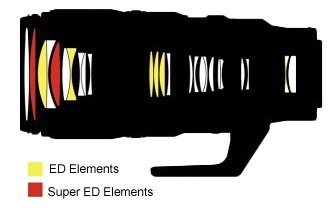The Nikkor Z 100-400 f/4.5 - 5.6 VR S Lens
Nikon Nikkor Z 100-400 mm f/4.5-5.6 VR S lens
When I switched to the Z6 mirrorless camera in late 2019 I traded in all of my DSLRs and over the following few months I switched most of my f-mount lenses for their Z-mount equivalents. At this time the longest native Z lens was the Z 70-200 f/2.8 VR S zoom. I initially kept my AF-S 300 f/2.8 G ED VR II and AF-S 500 f/5.6 PF ED VR lenses and TC-14EIII and TC-20EIII teleconverters for when I needed longer reach.
In 2022 the 300mm lens started to develop a fungal infection due to infrequent use so I sent it off for a clean and traded it against a Z9. This meant I had a big gap in focal range between 200mm (from the 70-200) and 500mm, 700mm and 1000mm (from the 500PF and teleconverters). I wasn’t sure whether to try a Z TC 2 with my 70-200 (giving 140-400mm range) or get a Z 100-400 f/4.5-5.6 VR lens. After some discussions with members of online forums I decided to buy the 100-400 lens. I have provided a brief review of this lens based upon the research I carried out in making the decision to buy, and from using the lens for a few months.
The Nikon Z 100-400 f/4.5 - 5.6 VR S lens was Nikon’s first long telephoto zoom lens. Until its release the longest native Z mount lens was the Z 70-200 f/2.8 VR S but it was soon joined by a range of telephoto primes giving Nikon Z users a number of options to reach 400mm. This lens offers exceptional performance and flexibility over a wide focal range.
The lens is part of Nikon’s S-Line of lenses which have become synonymous with quality. The impressive build quality includes a magnesium alloy core with a high quality plastic outer body having a high degree of weather sealing. There are 13 rings and 9 other gaskets around the various rings, switches and buttons.
Nikon Nikkor Z 100-400 mm f/4.5-5.6 VR S lens showing weather sealing measures
Like many of the Z-mount zooms, the barrel diameter stays almost constant throughout much of its length until you approach the lens mount. Also, like other S lenses, the Z 100-400 has an Electroluminescent (EL) display panel that can show focal length, aperture, focusing distance, and depth-of-field.
There is tripod collar that allows the lens to rotate and although the collar cannot be removed, its foot is removable. The lens foot is not Arca-Swiss compatible but can be exchanged for a third party offering or supplemented with a simple aftermarket Arca-Swiss lens plate. The supplied foot has two screw holes to prevent attached plates from twisting on the foot. The knurled locking knob on the tripod collar is fitted with a rubber cover which opens to providel a Kensington-compatible security lock point.
With the lens zoomed to 100mm, it is about the same size and weight as the Z 70-200mm f/2.8 VR S. The 100-400 measures 222mm ( 8.7" ) in length with a 98mm (3.9") diameter and weighs 1435g with the tripod collar. By comparison, the 70-200mm is 220mm (8.7”) length and 89mm (3.5”) diameter and weighs in at 1440g. Fully extended to 400mm, the lens grows about 50mm (2") in length whereas the 70-200 doesn’t extend due to its internal zoom design. The plastic HB-103 lens hood adds another 65mm (2.5") to the overall length, so, at 400mm the mount to front of hood distance is about 335mm (13.2"). That is remarkably small as regular 400mm lens would be closer to 400mm length without lens hood..
Comparison of the Nikkor Z 70-200 f/2.8 VR S lens (left) to the Nikkor Z 100-400 f/4.5-5.6 VR S (right) on a Nikon Z9
Comparison of the sizes of the Nikkor Z 100-400 f/4.5-5.6 VR S zoomed to 100mm (left) and 400mm (right)
Build and Ergonomics:
The Z 100-400 f/2.8 S follows Nikon’s new style - a simple black body with white text colour scheme with only the silver Nikkor S label to identify it as a high spec lens. Nikon has lost the gold accents and multitude of switches normally found on its high end F-mount lenses. The simple modern design of the new Z-mount lenses hides the complexity of the optical designs that make these S lenses some of the best performing and superior built lenses Nikon has ever made.
The lens consists of 25 elements in 20 groups. Six of these are Extra Low Dispersion (ED) elements, with two being Super ED type. There are no aspherical elements in the lens. Specific elements have super integrated multicoating (SIC), nano crystal coating and ARNEO coating to minimise reflections, ghosting and flare., and the front element is fluorine coated to repel water, dust and grease.
The maximum aperture is f/4.5 at 100mm, falling to f/5.6 at 400mm. Minimum aperture is f/32 at 100mm and again falling to f/40 at 400mm. The aperture diaphragm is 9 blades. The maximum aperture varies with focal length as the lens is zoomed from f/4.5 at 100mm, f/4.8 at 125mm, f/5 at 185mm, f/5.3 at 270mm and f/5.6 from 380mm up to the maximum 400mm. Minimum apertures at these focal lengths are f/32, f/36, f/36, f/40 and f/40 respectively.
The lens is fitted with a rubberised filter thread bumper that allows for 77mm screw in filters to be mounted.
The lens has three rubberised ribbed rings. Starting at the front of the lens there is a large zoom ring, then the manual focus/focus override ring and closest to the body there is a customisable control ring. All three turn smoothly with no indication of sticking or binding. The zoom ring is marked with focal lengths at 100mm, 135mm 200mm, 300,, and 400mm. The control ring function can be customised in the camera body (Custom Settings > f.Controls > f2 Custom controls assignment). By default the control ring offers aperture control, but can be customised to change exposure compensation, ISO setting or be disabled. Note the the zoom and focus ring positions are reversed compared to the other Z-mount f/2.8 lenses that have their focus rings towards the front of the lens barrels.
Nikon has designed the lens so that the center of balance moves only 3.8mm (0.15" ) as the lens is zoomed between 100mm and 400mm and focused. This means that the lens does not become front heavy like some other zoom lenses, retaining balance on the camera, particularly when mounted on a gimbal head. This also means that the lens won't zoom creep when held up or straight down.
Large zoom ring at top (nearest lens front), focus ring (centre) and narrower control ring closest to camera (next to tripod collar). Note the A/M switch on the left side of the lens barrel.
The lens is fitted with an Electroluminescent (EL) display panel and two push buttons, DISP and L-Fn. The display panel is similar to the top panel of the Z6 and Z7 cameras and shows Nikkor when the camera is first switched on, then can be used to display the zoom focal length, aperture or focus distance. The display turns off automatically after a short while but can be turned back on by pressing the DISP button. This button is also used to cycle through the information options that can be shown on the screen. When displaying focus distance the EL panel also provides depth of field ranges, something that can be easily missed unless you look down on the lens since the view from behind the camera is slightly obscured by the cut-out around the panel. I tend not to use the EL display much once its novelty had worn off, but this would be useful for low light and nighttime photography so you don’t need a torch to check on zoom or focus distance scales. The display may also be useful for those wishing to use hyperlocal distance to maximise image sharpness.
The L-Fn function button can be assigned using the camera menu. I set up the L-Fn options on my Z 70-200 f/2.8 S lens to initiate subject tracking.
Additionally, the lens has four L-Fn2 buttons arranged in 90 degree intervals around the barrel of the lens between the zoom and focus rings that can be programmed accordingly using the camera menu system. This is similar to the Nikon F-mount supertelephoto lens that have AF-ON or AF-RECALL functions at these positions. Unlike these F-mount lenses however there is much more customisation allowed with the Z-mount system.
Finally, there is a focus limiter switch that allows the lens to focus over its full range or between 3m and infinity.
Nikkor Z 100-400 f/4.5-5.6 VR S lens showing positions of the various control switches and control rings
Vibration Reduction:
This lens has in-built vibration reduction that is used in partnership with the In Body Image Stabilisation (IBIS) of the Z6, Z7 and Z9 series cameras. The combined Synchro VR offers full 5 axis (pitch, roll, yaw, horizontal and vertical) image stabilisation with this lens and is claimed to provide up to 5.5 stops of correction. There is no VR ON/OFF or VR MODE switch on the side of the lens - this is controlled through the in camera menu system where it can be enabled or disabled, and its mode can be set to Normal or Sport.
Focus:
The autofocus system in the lens uses two stepping motors controlling multiple groups of elements, and focuses down to 0.71m (27”) at 100mm and 0.97m (36”) at 400mm. This gives a maximum magnification ratio of 1:5 at 100mm and 1:2.5, at 400mm. Focussing is fast and quiet - there is a slight hum but this is much lens noticeable than the chattering associated with f-mount lenses, particularly when used in AF-C mode.
The lens is compatible with the Nikon Z teleconverters. With the 1.4x the maximum magnification reaches 1:1.8 (at 560mm), while with the 2x the ratio is 1:1.3 (at 560mm).
The 100-400mm is not a true parfocal zoom so there is a degree of focus shift when zooming, but his is less than most zooms. It does mean that you will need to re-focus if you zoom after achieving a focus lock. Focus breathing, where the size of the image varies with focus distance, is also negligible.
The lens can be switched into manual focus using the switch on the side of the lens barrel or via the menu system in the camera. Manual focus of the lens uses a “fly-by-wire” focussing ring that is speed sensitive, so the faster you turn the lens ring the more it moves focus.
The lens also has a manual override for autofocus, so for example, you can turn the focus ring while in autofocus mode with the shutter half pressed (or the AF-ON button pressed) to fine tune the focus, including using the rangefinder and focus peaking options in the viewfinder.
There is a focus limiter switch on the side of the lens that selects between full range or a restricted range between 5m and infinity. Where subjects are always going to be far enough away from the lens, selecting this limit speeds up the AF system even further and reduces the possibility of focus hunting. This is similar to the system on many of Nikon’s telephoto lenses.
Image Quality:
Over the range from 100-300mm the sharpness is excellent even wide open at maximum aperture. Above 300mm, stopping down to f/8 makes the image slightly sharper. There is very slight pin-cushion at 100mm that increases to more noticeable distortion as you zoom in to 400mm but the in camera distortion correction works well and unless you turn of in camera it is not noticeable.
Chromatic Aberration is very low, with only a slight fringing when wide open.
Vignetting in extremely well controlled even wide open. This improves to become negligible once stopped down to f/8. Again, in camera correction renders the images completely free from any darkening in the corners of the frame. Similarly, there is no evidence of flare from the lens even without the lens hood being fitted. This shows the effectiveness of the various coatings that Nikon has applied to the glass elements.
Vignetting at 100mm f/4.5
Vignetting at 400mm f/5.6
While not technically a true macro lens, the Z 100-400 is incredibly sharp at its closest focus distances even wide open. The images below show the box from a Nikon MB-N11 box demonstrating the sharpness possible with this lens.
Nikkor Z 100-400 f4.5-5.6 VR S at 100mm, f/4.5, closest focus distance of 0.71m
1:5 (0.2x) magnification
Nikkor Z 100-400 f4.5-5.6 VR S at 400mm, f/5.6, closest focus distance of 0.97m
1:2.5 (0.4x) magnification
For a variable aperture zoom, the bokeh performance is very good, backgrounds are rendered nicely without any indication of artefacts that are present in some lenses.
Filters
The lens has an 77mm filter thread for circular screw-in filters but unlike the Z trinity lenses (14-24, 24-70 and 70-200 f/2.8 zooms), it cannot accept the HB-97 lens hood from the Z 14-24 f/2.8 S lens. The filter thread is plastic so you need to be careful when screwing in filters. I use Kase Wolverine magnetic filters and so leave a small adapter ring on the lens at all times.
The Technical Bits:
Mount Type: Nikon Z Mount
Focal Length Range: 100-00 mm
Aperture Range: f/4.5 to f/32 (100mm) f/5.6 to f/40 (400mm)
Aperture Blades: 9 (rounded)
Filter Size: 77mm
Lens Elements: 25
Lens Groups: 20
Special Elements: 2 Super EDl, 6 ED glass
Fluorine Coating: Yes
Nano Crystal Coating: Yes
Super Integrated Coating: Yes
ARNEO Coating: Yes
Electronic Diaphragm: Yes
Focus Motor: Dual AF-P Stepper Motors (STM), multiple groups
Internal Focusing: Yes
Internal Zooming: No
Vibration Reduction: Yes
Minimum Focus Distance: 71 cm (27”) at 100mm, 97cm (36”) at 400mm
Maximum Reproduction Ratio: 1:5, or 0.2x Magnification at 100mm, 1:2.5, or 0.4x Magnification at 400mm
Weather/Dust Sealing: Yes
Mount Material: Metal/Plastic
Dimensions (Diameter by Length): 98mm diameter x 222mm (3.9 x 8.7 inches) at 100mm, 272mm ( 8.7" ) length at 400mm (lens hood not included)
Weight: 1435g (3.2ib) with tripod foot, 1365g (3.0lb) without tripod foot
Angle of View: 24° 20” (at 100mm) to 6° 10’ (at 400mm)
Conclusion:
It is difficult to find fault with the Nikon Z 100-400 f/4.5-5.6 VR S lens, even wide open at close range wide. The build, ergonomics and performance of the Z 100-400mm f/4.5-5.6 justifies its S-line status.
Pros:
Extremely good optical performance, especially sharpness
Very fast autofocus
Excellent build quality even considering its use of high quality plastics
Advanced weather sealing
Nikon’s most advanced features including dedicated control ring, L-Fn and 4x L-Fn2 function buttons, and an EL display
No shift in centre of gravity when zooming means that you don’t have to rebalance when mounted on a gimbal head
lens doesn’t creep when held vertically
Cons:
Cost, expensive for a variable aperture zoom
Focus-by-wire design can be frustrating for manual focus.











